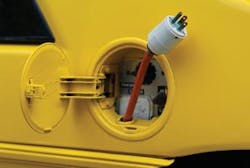Whether it’s the magnificent new terminals, larger, more efficient jets, up-scale dining or cleaner cost-effective GSE, airports continue to evolve.
Wherever one looks, JFK, BOS, SFO or EWR, electric vehicles are becoming more prominent. In the past it was only legacy carriers leading the charge to comply with government entities. Now the ever-popular low-fare carriers along with regional airlines are realizing the operational and maintenance advantages of alternative fueled tractors, pushbacks and utility vehicles.
The entire industry has taken notice of these important changes on the ramp. Many of the global ground handling companies in North America are now sourcing electric GSE. There is still a push for financial directors to save every dollar possible, but many business savvy purchasing directors are starting to understand the long-term benefits of switching from fossil fuel to electric.
Debunking the Myth
The North American market is truly starting to think outside the box. While an electric tractor used to be the minority in an airline’s fleet, it is now the benchmark at several key hubs. There used to be a myth these vehicles did not perform well in very cold or extremely hot environments. However, the technology for batteries, controllers and fast chargers has improved, thereby debunking the myth. It is not only bag tractors benefit from the electric evolution. Various sizes of pushbacks and utility vehicles have also become readily visible on ramps from coast to coast.
While batteries continue to escalate in price — although not as quickly as fuel — international cargo carriers continue to progress from gas and diesel tractors to electric. Part of the deterrent in the past has been the small operating window these carriers must adhere to in order to meet service levels. Electric cargo tractors have been reconfigured to accept industrial batteries up to 750Ah. The additional amp hours can improve run-time and the weight of the larger battery can also increase towing capacity depending on the application.
Over recent years, regional airlines have discovered how to cross-utilize an electric tractor. Some bag tractors are equipped with a sizable front tow hitch to push back an airplane once it’s finished hauling the bag carts. Other regional and major carriers have also discovered significant savings by investing in smaller electric utility vehicles for gate and mail operations, many times retaining 30 percent of the per unit capital expense. Three and four-wheel tractors with more than eight-ton towing capacity are ideal for passenger nose to tail operations or staging cargo. Small electric tractors are also good for moving almost anything around a GSE shop in a mule application. Another way to save money is by saving time. Electric high-speed flat bed tractors can travel up to 25mph and have raised the bar in Inter-line mail/baggage operations. Six hundred amp hour batteries and a sophisticated 80V AC controller system proven these vehicles are a worthy investment for ground handlers bidding airport contracts.
Technology continues to come of age in the tractor, pushback and utility vehicle arena. AC powered vehicles have become so affordable it can be challenging to find and purchase DC technology. Four major brand name AC electronic controllers are now available for certain bag tractor models.
While controller companies used to require a laptop computer to diagnose and tweak parameters on a tractor, the new models are available with sophisticated hand held tools. Not only is it more convenient for the technician due to its remote capability, but it comes at a more attractive price. More importantly, the supply chain for the majority of these suppliers continues to improve and the reliability of AC power is therefore confirmed.
The airline industry is familiar with the success of small towbar-less electric aircraft tractors. In addition to smaller applications, the demand for medium-sized conventional pushbacks is spiking worldwide. Many airlines are considering replacing aged diesel pushbacks with electric models.
Pushbacks are not the only piece of the green ramp revolution. Electric lavatory service trucks are also sneaking their way into the fiscal budgets of airlines, especially, at regional airlines where 40-50 RJ’s need quick service in one shift, on a single charge. Today technology exists which not only provides enough battery run-time to work a large fleet of aircraft, but these vehicles can travel to and from the waste areas, quickly and at high speeds.
Several suppliers have introduced hybrid vehicles to the marketplace. Hybrid will soon serve a niche at airports in North America as it has in Europe. A customer’s ramp to bag room or outdoor to indoor operating ratio must be determined to maximize a diesel/electric hybrid’s performance. At this moment, the best fit for a hybrid tractor is long mail or cargo runs. While hybrid technology has arrived, it may only be an intermediate step. As Hydrogen fuel cells become more compact and affordable they will surely become more prevalent. The possible challenge here is the availability of Hydrogen infrastructure on the port.
In conclusion, airlines, ground handlers and cargo carriers continue to bounce back financially. It will be the supplier’s duty to inform and educate the customer on every level regarding the availability, as well as the features and benefits of all new technology — especially alternative fuels.





